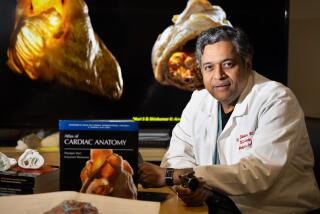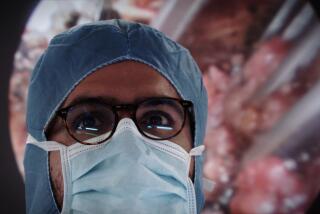Sure Hands
- Share via
In repose, the hands of Donald Becker are anything but remarkable: the fingers, short; the palms, broad; the cuticles and thick nails neatly trimmed. The hands are unexpectedly soft, and the lightly tanned skin lies like vellum across taut ropes of veins and tendons.
At different moments, they are hands that frame a problem, that orchestrate a talk, that cup the chin in contemplation, that rein in a horse, run a stick shift through its paces, grasp a tennis racket.
These also are the hands animated by a mind schooled for more than 35 years in the meticulous choreography of micro-neurosurgery. And at this moment, these hands, encased in the latex sausage skins of surgical gloves, are poised at a portal into the human brain itself.
For Becker, chief of UCLA Medical Center’s division of neurosurgery, and the 72-year-old man on whose brain he is operating this day, both a life and a livelihood are concentrated in this one pair of hands.
“The hands are the brain at work . . . a reflection of the brain,” says Becker, 62. “There is a beauty in how a person can move their hands. If one watches the hands of surgeons, there is a tendency for the movements to be fluid. The hands of a scholar often are more deliberate, more discoordinated.”
Guided by an operating room microscope wrapped in sterile surgical drapes, Becker is reaching delicately through a deliberate gouge in the skull behind the patient’s right ear to excise a tumor nestled at the base of the man’s brain. The benign tumor--perhaps an inch in diameter--is a pulse of moist purple lodged between an artery and the white thread of a nerve that controls facial movement and sensation. By pressing against the nerve, the tumor is causing the patient excruciating pain.
There is barely two-tenths of an inch clearance for Becker’s hands to operate in, because the tumor has wrapped itself around the tissue that sheathes the nerve.
Easy enough to see through the microscope, the tumor is so difficult to cut away safely that the operation to remove it will take more than nine hours, a dozen people and this special pair of hands.
So much depends on his sure touch that Becker is understandably protective of his hands. He keeps a wary eye on power tools, but doesn’t shy way from using them. He does not hesitate to ski or play tennis. He wears gloves when he rides, but not when he is driving. He trims his nails himself with clippers. Rarely do they receive a professional manicure.
“I don’t really do that much to pamper my hands. I am probably not a terribly compulsive person about physical appearance and general organization, as many neurosurgeons are,” Becker says. “So I don’t see myself as focused on physical appearance, such as details of how one’s fingers should actually look or be to protect them.
“I do what the moment requires. If I pick up a hammer and I am nailing, I will definitely wear gloves. When I am riding, I wear gloves . . . soft leather gloves,” he says.
The one thing he won’t do is place his hands out of his line of sight. “I am very careful when there is a situation that puts my hand out of my direct sight and at potential risk--where you can’t see exactly what is going on.”
Only once has he injured his hands.
Five years ago, during a tennis volley with his wife, Maria, he sprained the first joint of his right index finger returning an overhead smash. To almost anyone else, the sprain would have been no more than a minor and only mildly painful inconvenience. But for Becker, the lingering consequence of that injury is one measure of a surgeon’s dependence on manual dexterity.
The small sprain was enough to impair Becker’s ability to perform brain surgery for five months and, when several hand surgeons recommended that it might be necessary to fuse the finger joint permanently, it briefly threatened to forever damage his abilities as a neurosurgeon. (His hands are not insured.)
“It worried me quite a bit because I was concerned that it wasn’t going to heal,” Becker says. “It is probably the second-most important joint a person has because it is the joint that allows you to hold something against your thumb.
“I have full range of movement now. [But] the joint is still swollen.”
To ensure that his hands can operate at their peak during the most delicate phases of microsurgery, Becker now routinely leaves the preliminary surgical preparations--the physical work of opening and closing of the skull--to trusted colleagues under his supervision, so that he can concentrate solely on the critical microsurgery. In this case, he is assisted by UCLA head and neck surgeon Rinaldo Canalis and chief neurology resident Linda Liau.
“It is much better for the neurosurgeon to do the delicate work,” he says. “If you are just doing very fine work with your hands, the hands themselves don’t fatigue.”
*
As Becker tugs and worries at the brain tumor, he supports the weight of his left hand by bracing the pinkie against a surgical clamp. The fingers of his right hand, holding a pair of blue cauterizing tweezers, tremble slightly. After two hours of surgery, it is the only hint of fatigue or cramping.
“If you are completely focused on the problem at hand and not allowing your mind to drift off into other things, it is really quite easy to be there without moving and staying focused on a very specific, very small point for hours,” he says later. “I have been there sometimes for seven, eight, nine hours, barely moving. Then when the [operation] is completed, I will look up at the clock and be absolutely amazed that so much time has gone by.”






